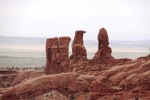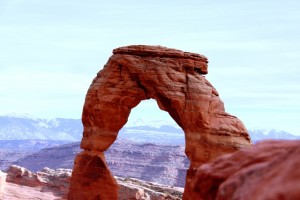By Kimberlee E. Frederick
Boasting more than 2,000 natural sandstone arches, myriad outdoor activities for the adventurous visitor, numerous plants and animals and a rich history that goes back thousands of years, Arches National Park near Moab, Utah exceeds the qualities of the typical tourist destination.
Open all year round, Arches’ most identifiable allure is the world famous Delicate Arch. Former Arches Interpretive Ranger Jim Blazik insists that arch “is probably one of the best known features in all of Utah.”
At 52 feet tall, Delicate Arch’s dramatic formation makes it a popular hiking destination for visitors to the park. A moderately difficult, three-mile trip on the main trail, hiking to the arch exposes to hikers the geology of the area and offers a sweeping view of the southern portion of the park. “It’s definitely a memorable place,” said Blazik. “People just want to hang out and ‘wow’ about it.”
Though not all of the park’s 2,000 arches are as recognizable as Delicate Arch, there is no shortage of remarkable sites for park visitors to enjoy. Landscape Arch, for example, measures 306 feet long from base to base, making it the longest arch in the entire park. Beyond that, spires, balanced rocks, eroded monoliths and sandstone “fins” are scattered throughout the park, exhibiting a chaotic geologic history that includes millions of years of erosion and deposition.
The arches and other natural formations themselves formed as a result of the land’s location on an underground “salt bed” that is in some places thousands of feet thick. 300 million years of debris erosion and sandstone deposits eventually resulted in many of the notable structures that attract visitors to Arches today.
Although the natural wonders spanning Arches National Park have drawn in admiring visitors for more than a thousand years, hunter-gatherers claimed the area for other uses at the end of the last ice age 10,000 years ago. More recently, about 2,000 years ago, the land was cultivated by nomads who left behind pottery and artifacts as evidence of their residence in this portion of eastern Utah.

Since it was first discovered, the history of the Arches area was broadened when Spanish missionaries went through the region to create a route through the deserts to their California missions. From there, recognition of the area’s natural beauty and unique structures steadily increased. In 1929 Herbert Hoover declared Arches a national monument, and in 1971 Congress gave it the enhanced status of a national park.
If the 10,000-year history — the complex story behind the geology and the awe-inspiring rock formations — aren’t enough to attract visitors internationally, the breadth of outdoor activities for every type of tourist imaginable adds even more incentive to visit Arches.
“This is a place set aside because of its geology, but you sure don’t have to be a geologist to be impressed,” Blazik said. Besides the must-do hikes to the more notable arches, Blazik notes that “there are a number of trails, from some that are even wheelchair accessible to longer trails that take a day or a day and a half.”
 It is the variety of hikes that helps to make Arches an ideal family park. The multitude of less strenuous hikes is ideal for kids and visitors of limited mobility. One of the easier hikes that Arches offers, The Windows is a trail that Blazik called “one of the most popular.” A one mile long hike round trip, it leads to three remarkable arches—North Windows Arch, South Windows Arch and Turret Arch.
It is the variety of hikes that helps to make Arches an ideal family park. The multitude of less strenuous hikes is ideal for kids and visitors of limited mobility. One of the easier hikes that Arches offers, The Windows is a trail that Blazik called “one of the most popular.” A one mile long hike round trip, it leads to three remarkable arches—North Windows Arch, South Windows Arch and Turret Arch.
Hikes through the area of Arches called the Fiery Furnace also rate high in visitor popularity. Three hours long, the hikes are usually considered moderately difficult and require proper hiking gear. Blazik notes that he has gotten some of the most remarkable tourist reactions from the Fiery Furnace, through which he led a number of hikes when he worked at Arches. “You’d see it in somebody’s eyes, or they would just come out and say it—it usually really affected them,” he said.
Camping is another popular visitor activity that Arches does not fail to accommodate. According to Blazik, “The Devils Garden is a

popular site for camping,” where campers have year-round access to restrooms, portable water, picnic tables and grills and, at some sites, room for RVs up to 30 feet in length.
Located about 18 miles from Arches’ entrance, Devils Garden is ideal for new and seasoned visitors alike. Fifty individual campsites are available for up to 10 people March through October. Reservations for group campsites for 11 or more people are also available at two different sites. The Juniper Basin site can hold up to 55 people and is available March through October, and the Canyon Wren site has room for up to 35 people and is open year-round.
Climbing at Arches is a big draw, but adventurers need to know the strict regulations that Arches has in place. A list of arches and bridges that are designated as off limits to climbing of any sort is given to visitors interested in climbing. While this list bans a number of structures for climbing, it leaves much of the park’s rock open. Arches is adamant about banning any climbing activity that removes plant life from the rocks or changes the physical shape of any of the structures.
Part of the Colorado Plateau, Arches is located in what is called a “high desert,” and temperatures therefore vary significantly from season to season. Even during the day, the temperature can fluctuate up to 40 degrees from the day to the night.

Weather in Arches and the surrounding Moab area can get extreme in the winter and summer months, with January typically being the coldest month and July the hottest. Summer temperatures, often more than 100 degrees, make the more strenuous activities offered at the park difficult. Intense storms often accompany summer nights, frequently causing flash floods.
Snow during the winter months is not uncommon, though typically the area does not get especially heavy snowstorms. Rain is regular, with the heaviest rainfall usually occurring in October. As such, Blazik said that the best time to visit Arches “is during the spring or fall, because it’s definitely more temperate.” Indeed, the temperature during these seasons is between 60 and 80 degrees during the day and 30 to 50 degrees at night.
Arches National Park is a land set apart for its rich history and intriguing geology. From the nomads of thousands of years ago to eager tourists visiting the park yearly, interest in the natural wonders of Arches has never waned. An ideal place for lovers of awe inspiring sights, the complex terrain within Arches “is very forgiving,” Blazik said, “but it’s rugged, too. At the same time, it’s also a fragile place, and there’s a lot that can be said for that.” From gentle trails to strenuous hikes, there is something for everyone coming to Arches. Still, “It’s not Disneyland,” Blazik urges visitors to remember. “It’s for real out there.”
Arches National Park is open 24 hour a day all year round. For more information, please visit http://www.nps.gov/arch
Photos by R. Shandley


